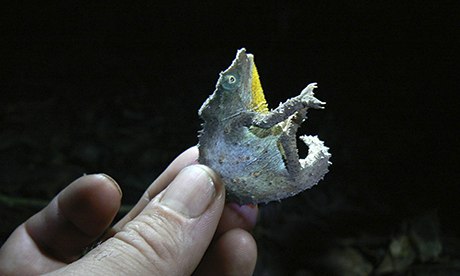Mount Mabu rainforest teeming with new and unique species including pygmy chameleons and bronze-colour snakes

This pygmy chameleon is one of many such unique and new species discovered in the Mount Mabu forest of Mozambique. Photograph: Kew Gardens/Julian Bayliss
A remote rainforest in Mozambique discovered using Google Earth has so many new and unique species that it should be declared a protected area, scientists say. Pygmy chameleons, a bronzed bush viper and butterflies with shimmering yellow wings are among the species in the forests covering Mount Mabu in northern Mozambique.
Discovered in 2005 by scientists using satellite images, the forests, previously only known to local villagers, have proven to be a rich ecosystem teeming with new species of mammals, butterflies, reptiles, insects and plants. The mountain forests have been isolated from a much larger forest block for millennia, meaning there has been no migration between this site and the next mountain for tens of thousands of years, allowing unique species to evolve in isolation.
One such species is a golden-eyed bush viper with bronze-edged scales (Atheris mabuensis) which Julian Bayliss, a conservation scientist for Kew Gardens, found by stepping on during a survey. His team is also waiting to describe a further two species of snake. A new species of chameleon (Nadzikambia baylissi) has already been described from the site, and the researchers are also describing another. The size of a human palm, with a warm yellow chest, green eyes and a spiky crest along its back, Rhampholeon sp. are commonly known as pygmy chameleons.
Bayliss’s team has identified 126 different species of birds within the forest block, including seven that are globally threatened, such as the endangered spotted ground thrush (Zoothera guttata). There are an estimated 250 species of butterfly, including five which are awaiting to be described, like Baliochila sp., a vibrant specimen which has shimmering yellow wings dusted with black. New species of bats, shrews, rodents, frogs, fish and plants are also waiting to be described.
“The finding of the new species was really creating an evidence base to justify its protection,” explained Dr Bayliss, “and now we’ve got enough to declare a site of extreme biological importance that needs to be a protected area and needs to be managed for conservation.”
In first step to making the forest an internationally recognised protected area – such as a national park – the team have submitted an application to have its importance officially recognised . This “gazetting” application has been accepted on a provincial and national level, but is currently waiting to be signed by the government.
If the application is successful, then the forest will be protected from logging concessions seeking valuable hardwoods currently threatening the mountain.
“The people who threaten Mabu are already there, and really what we’re trying to do now is a race against time towards its conservation. It’s getting there early enough to get the wheels in motion to make it a protected area before it’s too late,” said Bayliss.

